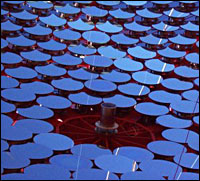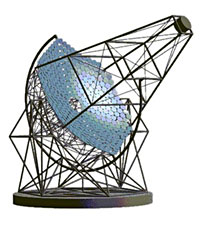WASHINGTON, Feb. 1, 2010 — The American Astronomical Society (AAS) has awarded the 2010 Rossi Prize to three scientists and the High Energy Stereoscopic System (HESS) collaboration for their outstanding contributions to imaging of very high energy (TeV) gamma rays. Their work addressed fundamental questions related to particle acceleration and the origin of the cosmic rays through the study of supernova remnants, pulsar wind nebulae and nearby active galactic nuclei.

Reflector plane of one of the HESS telescopes. (Images: HESS Collaboration)
The individual awardees are Felix Aharonian of the Dublin Institute for Advanced Studies in Ireland and Werner Hofmann and Heinz Voelk of the Max Planck Institute for Nuclear Physics in Heidelberg, Germany. Their award includes $1500 and an invitation to give a joint lecture at the 217th AAS meeting in Seattle in January 2011.
HESS is a system of imaging atmospheric Cherenkov telescopes that investigates cosmic gamma rays in the 100 GeV to 100 TeV energy range and is located in Namibia. Germany and France are the major financial contributors in the HESS collaboration.
The AAS High Energy Astrophysics Division (HEAD) awards the Rossi Prize in recognition of significant contributions as well as recent and original work in high-energy astrophysics. The prize is in honor of professor Bruno Rossi, an authority on cosmic ray physics and a pioneer in the field of x-ray astronomy.

A HESS telescope.
In addition, a new award was instituted this year: the HEAD Dissertation Prize, which is given in recognition of an outstanding doctoral dissertation in high-energy astrophysics. The 2010 Dissertation Prize was awarded to Dr. Brian Metzger, a NASA Einstein Fellow at Princeton University. Metzger was selected for his thesis, “Theoretical Models of Gamma-Ray Burst Central Engines,” which he wrote while at the University of California at Berkeley. He will receive a cash award and an invitation to give a talk at the upcoming HEAD meeting in Hawaii.
For more information, visit: www.mpi-hd.mpg.de/hfm/HESS